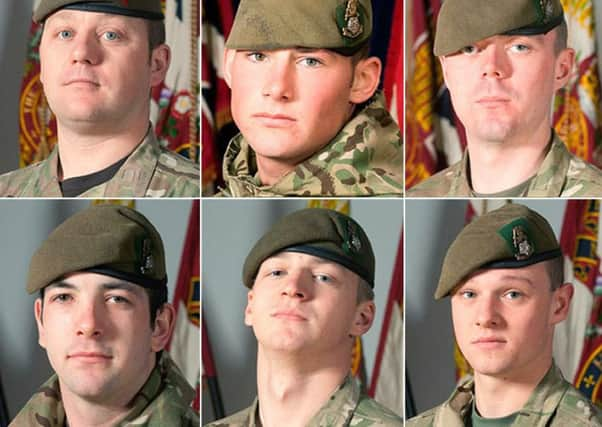Officer defends patrol that left six troops dead


The troops, including five from the Yorkshire Regiment’s 3rd Battalion, are thought to have died almost instantly when the Warrior fighting vehicle they were travelling in triggered an improvised explosive device, or IED, on March 6 last year.
Speaking at the first day of the inquest into their deaths, Oxfordshire Coroner Darren Salter told the families of the soldiers he hoped the hearing could help them to “get some closure” over their deaths.
Advertisement
Hide AdAdvertisement
Hide AdRelatives of Yorkshire soldiers Corporal Jake Hartley, Privates Anthony Frampton, Daniel Wilford and Christopher Kershaw joined families of Lancashire and Chesire colleagues Sergeant Nigel Coupe and Private Daniel Wade to listen to the evidence about the tragedy.
They heard a senior Army officer defend the use of ‘ground dominance’ patrols like those carried out by the soldiers at their time of their deaths as being vital for reassuring locals and keeping insurgents at bay.
Two armoured Warrior vehicles from the 3rd Battalion’s Corunna Company had been due to go out earlier in the day but the patrol was cancelled due to sandstorms, a common occurrence in Afghanistan’s Helmand Province.
The task was postponed for two hours until after 6pm, a decision that ultimately meant 19-year-old Pte Kershaw, from Bradford, ended up stepping in at the last minute because the planned driver wasn’t ready.
Advertisement
Hide AdAdvertisement
Hide AdFoot patrols were often used to engage with locals, as well as making it easier for soldiers to spot IEDs on the moon-like terrain. But the inquest was told that with dusk approaching there was not enough time to send a foot patrol out and bring them back while it was still light.
Major Edward Colver, officer in command for Corunna Company and with responsibility for the patrol base, said the sandstorm from earlier in the day had ended by the time the patrol went out.
He said because surveillance devices had been down there was a period “where we have been unable to project our force” and a ground patrol after such a period was “standard procedure, to project our force and to reassure the local nationals”.
Maj Colver added: “We wanted to show the insurgents that any activity they want to to do against us is not going to go unnoticed.”
Advertisement
Hide AdAdvertisement
Hide AdHe told the hearing it was “perfectly light” when the troops left the base and he “wouldn’t have had time to send a patrol out on foot” and get them back before it got dark.
He added: “The idea of the Warrior is to project your force on the ground, we are also going to go much more quickly so can cover more ground.”
Maj Colver revealed there were seven incidents when vehicles drove over an IED during the company’s tour, and that a Warrior went over one just a week after the deaths.
“The damage was pretty consistent in the remainder of the IEDs in that it would blow up the tracks and the road wheels. Thankfully the integrity of the turret and driver’s hatch remained. There were very minor injuries, a couple of shrapnel wounds.”
Advertisement
Hide AdAdvertisement
Hide AdHe denied the patrol on March 6 was “last minute” and said it had been postponed from earlier in the day, telling the inquest: “I saw a window of opportunity to get out and do a ground patrol.”
Defending his decision to send the troops out, he said: “In 2008 we were completely fixed in our compound, we couldn’t move out, the insurgents were able to get so close to us.
“The benefit of Warriors is that we are able to project our force. The history of IED around Lashkar Gah was low, the small arms rate was low. Projecting our force keeps our enemy on the back foot and keeps them away from our back door.”
He said if he had not sent them out it would have been 20 hours without a patrol by the time the next one was despatched, and added: “I deem that too long.”
Advertisement
Hide AdAdvertisement
Hide AdEarlier the inquest was told the blast crater was between 2.5 metres and 3.5 metres in diameter and with a depth of between 0.8 metres and 1.4 metres.
A post-mortem examination carried out by pathologist Dr Nicholas Hunt on father-of-two Nigel Coupe concluded that the blast “rendered him deeply unconscious” and that “there was no evidence that he was breathing while the fire was in progress”.
Similar conclusions were reached for the other five soldiers, whose cause of death was given as “blast injuries caused by an explosion”.
The hearing continues.